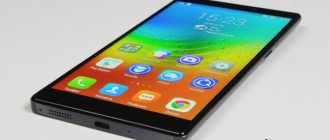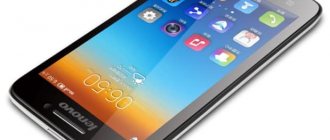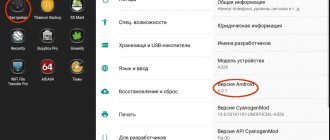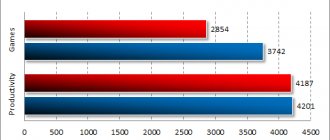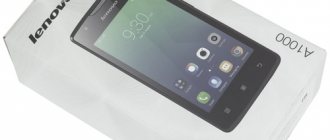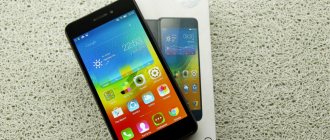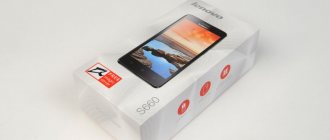There has been some kind of confusion with the new Lenovo smartphones - rumors about them have been circulating since the beginning of the year, and so far they have only been seen inside the company - photographs, no exact characteristics - none of this has been on the Internet until now, which is strange. With the flagship model, which is presumably called Vibe X3, things are still the same - just guesses and conjectures. But the new mid-price smartphone Vibe S1 is finally - after six months of waiting - officially presented. So this time we will do without rumors, in our test there are only dry facts.
⇡#Technical characteristics
| Lenovo Vibe S1 | |
| Touch screen | 5 inches, 1080 × 1920 pixels (431.95 ppi), IPS; Capacitive, up to 10 simultaneous touches |
| Air gap | No |
| Oleophobic coating | Eat |
| Polarizing filter | Eat |
| CPU | MediaTek MT6752: Eight cores ARM Cortex-A53 (ARMv8-A); Frequency 1.7 GHz; Process technology 28 nm; 32-bit and 64-bit computing |
| Graphics controller | ARM Mali-T760MP2, 800 MHz |
| RAM | 3 GB LPDDR3 |
| Flash memory | 32 GB + microSD (~25.5 GB available to user) |
| Connectors | 1 × micro-USB 2.0 1 × 3.5 mm headset jack 1 × Nano-SIM 1 × combined for Nano-SIM or microSD user selectable |
| cellular | 2G/3G/4G Two SIM cards in Nano-SIM format (the second is installed instead of a microSD memory card) |
| Cellular connection 2G | GSM/GPRS/EDGE 850/900/1800/1900 MHz |
| Cellular 3G | HSPA+ (42.2 Mbps) WCDMA 850/900/1900/2100 MHz |
| Cellular 4G | LTE Cat. 4 (150 Mbps / 50 Mbps) TDD Band 1/3/5/7/8/20 FDD Band 40 |
| WiFi | 802.11a/b/g/n + Wi-Fi Direct |
| Bluetooth | 4.0 + A2DP |
| NFC | No |
| IR port | No |
| Navigation | GPS, A-GPS, GLONASS |
| Sensors | Illumination, proximity, accelerometer |
| Main camera | 13 MP (4160 × 3120), BSI back-illuminated sensor, Autofocus, dual LED flash |
| Front-camera | 8 MP (3264 × 2448), BSI back-illuminated matrix, no autofocus + additional 2 MP front camera |
| Nutrition | Non-removable battery: 9.2 Wh (2420 mAh, 3.8 V) |
| Size | 143 × 71 mm Case thickness 7.7 mm |
| Weight | 131 g |
| Water and dust protection | Absent |
| operating system | Android 5.0.2 Jelly Bean Lenovo proprietary shell |
| recommended price | No data |
| Lenovo Vibe S1 – information about the system and hardware according to the CPU-Z application | ||||
⇡#Appearance and ergonomics
From the front side, the Lenovo Vibe S1 is extremely reminiscent of the slightly larger iPhone 6. Everything is similar: the proportions of the body, the radius of the corners, and the arrangement of elements above the display. The only thing that gives rise to vague thoughts is the large number of “black circles” next to the earpiece slot. The reason for this is the second, additional lens of the front camera. We will tell you why it is needed in the appropriate section, but for now we will simply mention that it is there.
Lenovo Vibe S1 – front view
At the bottom of the front panel there are three touch navigation keys, standard for an Android smartphone: a menu of open applications, “home” and “back”. They don't have a backlight, but you quickly get used to using them blindly.
Lenovo Vibe S1 – hardware keys on the front panel
In general, we have no comments about the ergonomics of the device - it is convenient to use. Its dimensions are quite acceptable, by modern standards - during operation there is no need to hold the gadget with the second hand. The smartphone weighs a little: 131 grams - your hand doesn’t get tired of it, even during long-term communication.
Lenovo Vibe S1 – front panel
Its case thickness is moderate: 7.7 millimeters, which is good by modern standards, but nothing more - there are much thinner smartphones that have been on the market for a long time. However, the rounded back panel gives the misleading impression that the body is thinner than advertised. And this is good - the Vibe S1 seems fit and slender. Along the side ends of the case there is an edging with polished “bevels” to the front and rear panels.
Lenovo Vibe S1 – side end
The power key and volume buttons are located on the right side - under the thumb of the right hand. A standard, but very convenient solution. You don’t have to reach for the buttons; pressing them is convenient. The keys have a short and distinct stroke. Slots for Nano-SIM and Nano-SIM/microSD cards (user's choice) are hidden under a mechanical lock on the left side. The universal 3.5 mm audio output is located at the top end, and the microUSB interface is at the bottom. Next to it are the slots for the external speaker. Its location is good - it does not overlap with the palm, even if you hold the smartphone in landscape orientation.
| Lenovo Vibe S1 – side edges | ||
The body of the smartphone is made of aluminum. On the back panel there is a thirteen-megapixel main camera lens and a dual LED flash.
Lenovo Vibe S1 – rear panel
The device is assembled very well - we did not find any suspicious play during testing. The smartphone passed the twisting and breaking test without any problems - when the sides were squeezed, there were no “colored streaks” on the screen, there were enough stiffening ribs in the design. The smartphone will be available in two colors: Pearl White (white) and Midnight Blue (dark blue).
Ergonomics
Despite the glass body, the smartphone lies confidently in the hands and does not try to slip out, which is also facilitated by the rounded shape of the back. The thickness at its thickest point is 7.8 mm, and the edge is only 5.4 mm. The device weighs 132 g, and the dimensions are acceptable for a 5-inch device - 70.8 x 7.8 x 143.3 mm. It seemed to me that the unlock key was lowered a little lower than it should have been, but this is in the category of nitpicking. Otherwise, the smartphone is convenient to use.
⇡#Display
The smartphone is equipped with a five-inch screen with Full HD resolution. Its pixel density is high – more than 430 dots per inch. This resolution is quite enough to completely get rid of “pixelation” - individual dots on the Lenovo Vibe S1 display are absolutely impossible to see. All fonts, even the smallest ones, look sharp and are easy to read on the screen. Movies and photographs are well detailed. In general, there is absolutely no need for higher resolution - the display is very clear.
The device uses an IPS type matrix. Its viewing angles are very wide - the contrast does not drop even when looking away from the perpendicular. That is, black remains quite deep, even if you look at the screen at an angle. The gadget is responsive, it quickly and, most importantly, accurately responds to touch. In total, the device supports up to ten simultaneous clicks; It also detects “gestures” without any problems. There is a special mode that increases the sensitivity of the touch layer - it is designed for working with the device while wearing gloves.
Lenovo Vibe S1 – AnTuTu MultiTouch Test results
Despite the fact that the device is in the mid-price category, the screen here is made in the best possible way. It does not have an air gap between the protective glass and the matrix - the display is made using OGS (One Glass Solution) technology. The front panel with an oleophobic coating does not get dirty so quickly, and you can clean the screen from “fingers” and other dirt using a regular cloth. Finally, a polarizing filter is provided, so you can use the device without any problems even in bright ambient light, including direct sunlight.
The brightness reserve of the Lenovo Vibe S1 screen is large. The maximum luminosity of the white field is 462 cd/m2 (the minimum is only 14 cd/m2). You can comfortably use your smartphone in direct sunlight – the information on it remains readable, and you don’t have to strain your eyes or squint. The backlight boundaries are very wide, which is undoubtedly good. The gadget is equipped with a light sensor, thanks to which it can independently adjust the brightness level that is comfortable for working in certain conditions. It works quite correctly - the backlight level changes smoothly, correlating with external lighting.
The luminosity of the black field at the maximum brightness level is moderate - 0.47 cd/m2 (the lower the better). It looks rich, without deviations into dark gray. The contrast of the Vibe S1 display is very decent – 983:1.
Lenovo Vibe S1 – Grayscale Color Temperature
The white balance of the screen is well adjusted. The color temperature of shades of gray is very close to the reference value of 6500 K - it averages 6850 K, and with white the ideal value is achieved.
| Lenovo Vibe S1 – screen options | ||||
In the settings, the user can change the color tone (“cooler - warmer”) and saturation, but we see absolutely no need for this. The smartphone also has several special display modes, but we, of course, carried out all tests in standard mode.
| Lenovo Vibe S1 - gamma curve of gray (left) and color components (right) compared to the reference curve (indicated in yellow) | ||
As our further tests showed, the screen is configured very well out of the box. All gamma curves are close to the reference curve. This means that the display correctly displays midtones and does not try to lighten or darken them. The color rendition of the display is correct, which is, of course, very good.
Display
The oleophobic coating, by the way, is of very high quality; it is present on both the front and back. Fingerprints remain reluctantly on the surface of glass. And if they linger there for some time, they are easily removed by simply wiping them even on clothes. Although doing so, of course, is not comme il faut.
- diagonal 5 inches
- resolution 1920 x 1080 pixels
- dots per inch density 440 ppi
The official specifications indicate that an IPS screen is used. Perhaps this is how it really is, but it’s still hard to believe. I'll explain.
The color rendition here is not exactly lame, it is very weak.
Always, even at right viewing angles, the picture clearly gives off a green glow. This behavior is more typical for AMOLED matrices, which Samsung used a couple of years ago, but certainly not for IPS.
In the photo below, I compared our hero with the Bluboo XTouch, which is already starting to set your teeth on edge. The displays are different and, I must say, both devices are not of very high quality. “Lenovka” goes into a greenish glow (in the photo above or on the left), and “Blubu” (in the photo below or on the right) turns into blue-pink.
⇡#Hardware and performance
The smartphone is equipped with an eight-core single-chip system-on-chip MediaTek MT6752. This is an average solution in terms of computing power, which is quite consistent with the price category of the Vibe S1. It is noteworthy that all eight cores of this system are the same - Cortex-A53, operating at a frequency of 1.7 GHz. In general, eight cores of the same type are an exception in the world of mobile systems-on-a-chip. Typically, eight-core processors have two groups with four different cores at their disposal. Of course, as in other octacore platforms, the cores in the MT6752 can work all together, or, when performing simple tasks, they can work separately to save energy. The modern ARMv8-A instruction set is used, so the device supports both 32-bit and 64-bit computing. The microcircuit is manufactured using a 28 nm process technology.
There is a lot of RAM in the device - three gigabytes. Thanks to this, the user can keep multiple applications open, switching between them occurs very quickly. “Fast” LPDDR3 modules are used. The volume of built-in flash memory is 32 GB. You can install a microSD memory card into the device, but for this you will have to sacrifice a second SIM card - there is only one slot for them.
In general synthetic tests that check the speed of a computing system, the smartphone received very good marks. Judge for yourself, in AnTuTu Benchmark 5 the smartphone scored the same points as this year’s flagships: LG G4, Meizu MX4 Pro and Sony Xperia Z3+. These smartphones run on current platforms from more famous manufacturers: Qualcomm Snapdragon 808, Samsung Exynos 5430 and Qualcomm Snapdragon 810, respectively. MediaTek MT6752 managed to perform on par with them - this is certainly commendable. Moreover, in the “multi-threaded” task of Geekbench 3, our test subject even left his more eminent colleagues behind.
The MT6752 uses an ARM Mali-T760MP2 controller operating at 700 MHz as a graphics coprocessor. It supports OpenGL ES 3.1, DirectX 11 and OpenCL 1.1. The gadget copes well with video playback in HD and Full HD formats.
Things are a little worse with games. Even in the simple Basemark 2 Taiji test, the gadget showed “only” 45.2 FPS. Don’t get us wrong – the result itself is quite good, but most expensive modern smartphones limit this task to the vSync limit of 60 frames per second. This means that you can only play casual arcade games on the Lenovo Vibe S1. More resource-intensive applications on a smartphone slow down. Of course, you can reduce the graphics settings to a minimum, but you will hardly be able to achieve a perfectly smooth picture - it will still twitch periodically. However, this did not interfere with playing the eighth Asphalt. For the vast majority of everyday tasks, the Vibe S1 has enough power - only avid gamers will have reasons to complain. A typical situation for a smartphone of this class.
The Lenovo Vibe S1 runs very smoothly – apparently, the firmware is well optimized. During testing, the gadget did not slow down at all. It always did everything smoothly - which is great, especially for a mid-priced Android smartphone. True, our test subject also had one drawback: a couple of times during the time that the smartphone was with us, it stopped responding to controls. That is, we just used it and everything worked perfectly, and a second later there was a brick on the table. And only after a reboot did everything return to normal. This is probably a flaw in our pre-production test unit.
Autonomy
The built-in battery has a capacity of 2500 mAh and allows you to use your smartphone to the fullest for a day without any problems. I played games, watched YouTube, surfed constantly, used the camera, etc. If you cut down on your needs a little, the smartphone will easily last two days. It is not clear for what reasons, but PCMark shows an unreliable result:
⇡#Communication and wireless interfaces
As we said earlier, you can install two SIM cards in your smartphone. True, then the smartphone will lose a slot for microSD - this solution (a universal slot for SIM/SD) has recently been chosen by many smartphone manufacturers. True, it is not very convenient for the user: why should we choose between a second SIM and a flash drive? We want everything at once!
| Lenovo Vibe S1 – SIM card parameters | ||
Fortunately or unfortunately, we can’t tell you anything new about working with two SIM cards - it’s implemented here in the same way as everywhere else. And this is rather a plus - you definitely won’t get lost in the cards. After installing the SIM in the slots, a pop-up window will appear in which the user needs to determine which card to make voice calls with, which one to send messages with, and which one to access the Internet. These parameters can always be changed in the corresponding item in the settings menu. On the dialing screen there are two call keys - for both SIMs, which is convenient. The SMS log displays from which/to which SIM the message was sent/received. You can also see which card is installed under which number in the pop-up window that appears if you pull out the top “curtain”.
| Dial screen | Magazine | SMS/MMS |
One of the installed cards will be able to work in fourth generation networks. The device supports LTE Cat. 4 with a maximum theoretical data reception speed of 150 Mbit/s. During testing, the following problem was discovered: after leaving the Wi-Fi coverage area, the smartphone did not want to independently access the Internet via mobile networks. To force it to switch from Wi-Fi to 3G/4G Internet, I had to turn off Wi-Fi in the settings. Hopefully this software glitch will go away with a software update.
It is convenient to talk on the Vibe S1 - the speaker has a decent volume reserve, and the interlocutors did not complain about poor audibility. As for wireless networks, the device supports Wi-Fi of all popular protocols and Bluetooth version 4. We won’t complain about the lack of NFC and an infrared port - their presence is not necessary in an inexpensive model.
| Lenovo Vibe S1 – AndroiTS GPS Test results outdoors | ||
The radio module installed in the Vibe S1 is oriented to the terrain using GPS and GLONASS satellites. Determining the location occurs quickly and quite accurately: half a minute after launching the profile test, the gadget detected about twenty satellites in total and was guided by seventeen of them. The smartphone copes well with the role of a car navigator.
Calls, multimedia
There are no complaints here at all - the microphones work great, the voice is transmitted clearly, the speakers are loud and of high quality. The only thing I didn’t like was the location of the multimedia speaker a la Apple - I constantly covered it with my hand when exterminating terrorists in Modern Combat.
The sound of the smartphone surprised me - the sound is detailed and of high quality. Even the Audio-Technica MSR7 played well with the phone and produced decent sound.
⇡#Camera
Lenovo Vibe S1 – front cameras
The situation with cameras on the Lenovo Vibe S1 is interesting. The thing is that this smartphone has two front cameras: an eight-megapixel one with a BSI backlight sensor, and an additional two-megapixel one. With the first, everything is clear: it allows you to take good self-portraits and talk to video even in not very good lighting. Why does a smartphone need a second front camera? The answer is simple: to create artistic backgrounds on “selfie” photographs. Using this camera and clever software algorithms, a smartphone can “cut out” a portrait from the frame or artistically blur the background. All this, of course, happens after the photograph is taken. To be able to work with selfies in the future, you need to enable a special mode, which has an unusual name - “beautification”.
Lenovo Vibe S1 – in “beautification” mode the shutter button turns yellow, in normal mode it is gray
The algorithm of actions is very simple. The user takes a selfie, after which he goes to the gallery and sees two virtual keys under the photo: “smart focus” and “cut portrait”. This is only relevant for photos taken in the “beautification” mode.
Lenovo Vibe S1 – photo processing
The gadget copes well with blurring the background: it quite accurately identifies a person in the photo and does not blur unnecessary areas of the image - the result is a quite nice and in some places even believable bokeh effect. It is noteworthy that the user can choose not only the degree of background blur, but also one of three patterns (“Large Aperture”, “Rotate”, “Sprint”). The difference is visible in the screenshots below.
| Lenovo Vibe S1 – software background blur | ||||
When cutting out an object from the background, things are a little worse. The problem is that this process requires special care and attention, which the Vibe S1 automation cannot provide. According to the creators, the following should happen: you take a photograph of yourself, cut out your portrait from the background and superimpose it on another background, more attractive. The gallery has a whole collection of backgrounds prepared for this task. There is an option to “manually” cut out a portrait from a photo - with its help you can correct automatic errors.
| Lenovo Vibe S1 – cutting out a portrait from the background | ||
The main camera in the Vibe S1 is thirteen megapixel, with a BSI backlight sensor. It is equipped with an automatic focusing system and dual LED flash.
Lenovo Vibe S1 – main camera
In daylight, the main camera of the Vibe S1 takes good pictures. The photographs come out quite saturated, contrasting, with natural color rendition. The sharpness of the images decreases slightly towards the edge of the frame. Autofocus works quite accurately when shooting static objects. There can be difficulties when photographing moving objects - either the focusing system will make a mistake, or the automation will set the shutter speed too long, and as a result the photograph will turn out blurry. The same goes for shooting in the dark - one out of three night shots always turned out blurry. Otherwise, the Vibe S1 has a good camera.
Lenovo Vibe S1
View all images (7)Front camera
This time we’ll move the discussion of the front sensor into a separate section, because the manufacturer himself has emphasized the possibility of creating self-portraits.
The first thing you should pay attention to is the presence of two front cameras at once. This is not something you see every day, and there are very few models on the market that are equipped with multiple sensors (remember Huawei Honor 6 Plus and HTC One M8).
The main question is why? The hardware takes pictures of one module, the one with five megapixels. An auxiliary one (2 megapixels) is needed to measure depth of field. You can enable the corresponding function directly in the viewfinder interface. After that we take pictures as usual.
The magic begins when the software part comes into play. Each photo taken using two photo modules can be further edited.
For example, select an object in the foreground.
Or blur everything in front and focus on the rear object. The main thing is that in the process of photographing the camera recognizes people's faces. It will not be possible to focus on the asphalt, since its automation will not fix it during shooting.
You can additionally hang all sorts of frames and other frills. There is a certain freedom of choice here.
Another question is why is all this needed? I don't know. As for me, this is just self-indulgence and nothing more. You definitely don’t need to buy the Vibe S1 just for this feature.
⇡#Autonomous work
The battery in the smartphone is quite ordinary - 9.2 Wh (2420 mAh, 3.8 V). It is quite enough for a working day under standard loads: an hour of calls, 15-20 SMS, one and a half to two hours of mobile Internet, an hour and a half in navigator mode, half an hour in music player mode. The device never discharged until the end of the working day. If you use the gadget without fanaticism, you can extend the operating time by a day.
In continuous video playback mode at maximum brightness, with an active Wi-Fi connection and data updating in the background, the device lasted almost six and a half hours - a good result. Of course, there is no need to talk about record battery life, but I don’t want to complain at all about the small battery. Of course, to extend the battery life, it is enough to lower the screen backlight level and activate a number of software energy-saving options in the corresponding menu in the settings.
| Lenovo Vibe S1 – Power Saving Options | ||||
Equipment
This time they sent me a smartphone in a paper envelope without components or box. So I have nothing to unpack and take photos. Fortunately, I know how to use Google, where I found a picture of the device’s configuration. Don't thank me.
Inside the package there is a power cable, charger (5V, 1.5A), protective film and the usual documentation.
